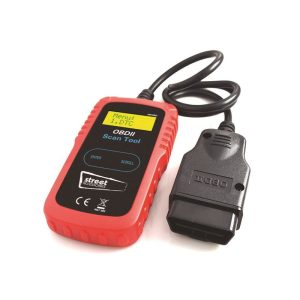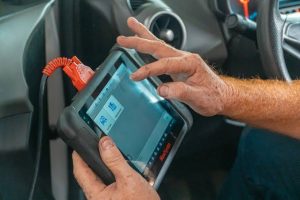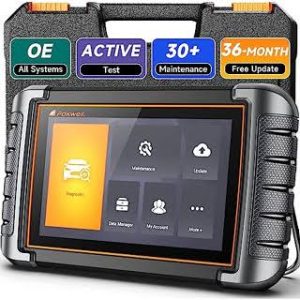In the modern automotive landscape, car computer codes, also known as Diagnostic Trouble Codes (DTCs), play a crucial role in maintaining vehicle health. These codes are generated by the vehicle’s onboard computer systems, primarily the Engine Control Module (ECM), to signal the presence of an issue within the vehicle’s various subsystems.
Understanding Car Computer Codes
Car computer codes are part of the On-Board Diagnostics (OBD) system, which monitors the performance of the engine, transmission, and other key components. When a potential issue is detected, the OBD system generates a specific code that corresponds to the nature of the problem.
These codes typically begin with a letter followed by four numbers. For example, codes starting with ‘P’ relate to the powertrain, ‘B’ codes are for the body, ‘C’ codes for the chassis, and ‘U’ codes are network communication codes. The numbers provide further detail about the specific issue.
The Importance of Car Computer Codes

The primary importance of car computer codes lies in their ability to facilitate quick and accurate diagnostics. By providing a standardized method of reporting problems, these codes allow technicians to pinpoint issues without extensive manual testing⁵. This not only saves time but also ensures that the correct repairs are made, potentially avoiding further damage to the vehicle.
Moreover, understanding these codes is not just for professionals. With the right tools, such as an OBD-II scanner, even car owners can retrieve these codes and gain insights into their vehicle’s condition. This empowers vehicle owners to make informed decisions about maintenance and repairs.
Car computer codes are indispensable in the realm of automotive diagnostics. They provide a language through which vehicles can communicate their health status, ensuring that both technicians and car owners can understand and address issues promptly and effectively. As automotive technology continues to advance, the role of these codes will only grow in importance, solidifying their position as a cornerstone of vehicle maintenance and repair.
Different Types of OBD Systems: OBD-I and OBD-II
The automotive industry has seen significant advancements in technology, especially in the realm of vehicle diagnostics. On-Board Diagnostics (OBD) systems or Car Computer Codes are a pivotal part of modern vehicles, allowing for the monitoring and reporting of vehicle performance and issues. There are two primary types of OBD systems: OBD-I and OBD-II. Understanding the differences between these systems is crucial for vehicle owners, mechanics, and enthusiasts alike.

OBD-I: The First Step in Diagnostic Systems
OBD-I was the first standardized system implemented to control vehicle emissions. Introduced in California in 1991, it was designed to be a universal diagnostic system. However, manufacturers were allowed to create their own OBD-I systems, leading to a variety of connectors and codes across different vehicle makes.
Vehicles equipped with OBD-I systems typically have a diagnostic connector located in the engine compartment. Reading OBD-I codes can be challenging, as the codes are not standardized and can vary significantly between manufacturers. For instance, a code in a GM vehicle might signify something entirely different in a Ford.
OBD-II: A Universal Diagnostic Solution
In contrast, OBD-II, introduced in the mid-1990s, represents a standardized system used across all vehicle manufacturers. This system was mandated by the California Air Resources Board (CARB) for all cars sold in California starting with the 1996 model year.
OBD-II vehicles have a standardized diagnostic port, usually found under the dashboard on the driver’s side. This port allows for a universal connection to the vehicle’s computer system, enabling the use of a common set of diagnostic trouble codes (DTCs) and making it easier to identify and address issues.
The Key Differences
The central difference between OBD-I and OBD-II is standardization. OBD-I systems varied by manufacturer, which meant that each brand required a specific scanner to diagnose issues. OBD-II, however, provides a universal diagnostic interface, with standardized codes that apply across all vehicle makes and models.
Another significant difference is the range of diagnostics. OBD-II systems monitor a broader range of vehicle systems and provide more detailed codes, allowing for more precise troubleshooting. They also support real-time data monitoring, which can be crucial for diagnosing intermittent issues.
Locating the On-Board Diagnostics (OBD) Port in Your Vehicle
When it comes to vehicle maintenance and troubleshooting, the On-Board Diagnostics (OBD) port is your gateway to understanding the health of your car. The OBD port allows for a diagnostic scanner to be connected, which can read and clear trouble codes, monitor real-time data, and perform various other diagnostics. Here’s how you can locate the OBD port in your vehicle.

Step 1: Understand What You’re Looking For
The OBD port is a standardized 16-pin connector where a diagnostic tool can be plugged in. It’s usually located within 2 feet (0.61 meters) of the steering wheel to ensure easy access.
Step 2: Check Common Locations
The most common location for the OBD port is under the steering wheel on the driver’s side. It can also be found near the center console, under the dashboard on the passenger side, or even under the hood near the engine in some models⁴.
Step 3: Look for a Cover
OBD ports are often concealed by a cover to prevent dust and accidental damage. The cover may be labeled with ‘OBD’, ‘Diagnostics’, or similar terms, or it might simply be a flip-down or slide-out panel.
Step 4: Consult Your Vehicle’s Manual
If you’re having trouble locating the OBD port, your vehicle’s owner’s manual is an excellent resource. It will provide the exact location and instructions on how to access the port.
Step 5: Use Online Resources
There are numerous videos and online tutorials that can guide you through finding the OBD port for specific vehicle models. These can be particularly helpful if you prefer a visual guide.
Step 6: When in Doubt, Ask for Help
If you’re still unable to find the OBD port, don’t hesitate to ask for help from a professional mechanic or a knowledgeable friend.
Locating the OBD port in your vehicle is typically a straightforward process. Once found, you can connect a diagnostic tool to uncover any issues and keep your vehicle running smoothly. Remember, the OBD port is a powerful tool in ensuring the longevity and performance of your car.
For those interested in delving deeper into this topic, resources are available that explain the nuances of these codes and how to interpret them for effective vehicle maintenance.
(1) How to Read Car Computer Codes – Total Car Diagnostics.
(2) Automotive Computer Codes Explained – Total Car Diagnostics.
(3) Understanding ECM Codes: A Comprehensive Guide – Medium. .
(4) Automotive Computer Codes Explained – Total Car Diagnostics. .
(5) Car Hacks: How to Program a Car Computer with a Laptop.
(6) How to Read Car Computer Codes – Total Car Diagnostics.
(7) Recognizing Bad Car Computer Symptoms – automotivegearz.com.


